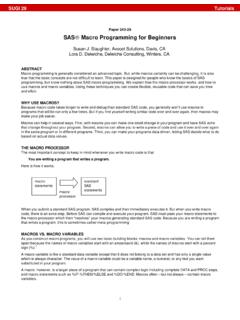Transcription of 028-2010: When Best to Use the %LET Statement, the ... - SAS
1 Paper 028-2010 When Best to Use the %LET Statement, the SYMPUT Routine, or the INTO Clause to Create macro Variables Arthur X. Li, City of Hope Comprehensive Cancer Center, Duarte, CA ABSTRACT macro variables are the most essential part of the SAS macro facility. One can create macro variables by using the %LET statement, the SYMPUT routine, or the INTO clause in the SELECT statement from the SQL procedure. Sometimes a SAS programmer is often unsure when best to use which method due to a lack in understanding each step of macro language processing. This lack in understanding includes how SAS statements are transferred from the input stack to the macro processor and DATA step compiler, what role the macro processor plays during this process, and when best to utilize the interface to interact with the macro facility during the DATA or SQL execution.
2 Once one grasps the intricacies of macro language processing, one will best know how to accurately create a macro variable. INTRODUCTION One of the most important components of Base SAS is the SAS macro facility, which includes macro variables and macro programs. One can use SAS macro variables and macro programming statements in a SAS macro program to generate SAS codes. In order to utilize the SAS macro facility, one needs to learn SAS macro language. Although the convention of the macro language is similar to SAS language, macro language is indeed a separate language that is used in the SAS macro program.
3 The prerequisites of learning macro programs begins with macro variables. In this paper, we will only focus on macro variables. To truly understand macro variables, one must grasp the mechanisms of macro processing. One excellent source for an introduction to macro processing is from SAS macro Programming Made Easy by Michele M. Burlew. In this book, Burlew cleverly uses figures to illustrate the mechanics of macro processing. The figures in this paper are adapted from the figures in her book. CREATING AND REFERENCING macro VARIABLES macro variables are either automatic, which is provided by SAS, or user-defined, which is created by SAS users.
4 We will only cover the user-defined macro variables in this paper. CREATING USER-DEFINED VARIABLES USING THE %LET STATEMENT One way to create a macro variable is to use the %LET statement, which has the following form. %LET macro -variable = value; The value is stored as character strings that can be ranged from 0 to 65,534 characters. Mathematical expressions that are stored as value are not evaluated. The case of the value is also preserved. If the value contains quotation marks that include literals, the quotation marks will be part of the value. Before assignment is made, any of the leading and trailing blanks will be removed from the value.
5 If macro - variable and/or value contain references to another macro variable, the reference will be evaluated first before the assignment. Also, if the macro -variable has already been defined previously in the program, value will replace the most current value. Here are some examples of defining macro variables by using the %LET statement. %let var1 = 4 + 3; %let var2 = hello; %let var3 = leading blank; %let var4 = " quotations "; The values of the macro variables just defined are summarized in the following table: macro variable name Value Notes var1 4 + 3 Mathematical expressions are not evaluated var2 hello var3 leading blankLeading blanks are removed var4 quotations Quotation marks are part of the values 1 Beyond the BasicsSASG lobalForum2010 REFERENCING macro VARIABLES Once a macro variable is defined, the value of the macro variable is stored in the global symbol table1.
6 In order to substitute a macro variable in the SAS program, you must reference the macro variable by preceding the macro variable name with an ampersand (&). The reference causes the macro processor to search the macro variable in the symbol table. Once the macro variable is found, the value that corresponds to the macro variable will be substituted into the SAS program. If the reference of a macro variable is within quotations, the double quotation marks must be used. Consider the following dataset, , which contains information for SEX and HEIGHT of each student. Suppose we would like to create an indicator variable, TALL, which is defined as either 1 for students who are taller than 63 inches or otherwise 0.
7 The number 63 could possibly be used multiple times in the program. Furthermore, the definition of TALL might change in the future; for instance, instead of using 63 inches, we might use 65. Thus, we can define a macro variable that contains the threshold value and reference this macro variable in the program. Since we use a macro variable to store this threshold value, if we are going to make changes for this threshold, we will only need to change it once in the macro variable definition. Program 1 below contains the partial code of the entire program: name sex height 1 John m 65 2 Tom m 60 3 Mary f 62 4 Helen f 64 Program 1: %let ht = 63; data ex1; set height; tall = height > run; In Program 1 above, to reference the macro variable HT, an ampersand (&) is placed in front of the macro variable HT.
8 After the substitution, the code will be as follows: data ex1; set height; tall = height > 63; run; SAS AND macro PROCESSING SAS PROCESSING In order to understand how macro variables are processed and stored, one needs to understand how SAS processing works. Once a sequence of SAS code is submitted, it is processed in two-phase sequences: the compilation and execution phases. The compilation phase is performed by the compiler. Before the SAS code is transferred to the compiler, the codes are placed in a memory area, which is called the input stack. Next, the word scanner takes the SAS code from the input stack and breaks that code into words or symbols, which are called tokens, and directs the tokens to the correct destination, such as the compiler or the macro processor.
9 When the compiler receives the semicolon following the RUN statement, it stops accepting tokens from the word scanner. The compiler then compiles the received tokens, checking for syntax errors. If there are no syntax errors, the execution phase begins (see Figures 1a-c for illustrations). The types of tokens that the compiler recognizes are illustrated in following table: 1 In addition to the global symbol table, there are also local symbol tables. The local symbol table is used within the macro definition. Since we are not covering macro programs, we will only use global symbol table in this paper.
10 For simplicity, the symbol table in this paper will be referred to as the global symbol table. 2 Beyond the BasicsSASG lobalForum2010 Types of Token Examples Literal Characters enclosed in quotation marks John John Number Numerals including decimals, E-notation, date, time, and datetime constants, and hexadecimal constants 555 01mar2010 d 30e4 Name Characters that begin with a letter or underscore and that continues with underscores, letters, or numbers. A period can sometimes be part of a name _n_ means descending Special character Characters other than a letter, number, or underscore that have a special meaning to the SAS system * / + % Figure 1a.

















